Insider Secrets Magazine by ecoMaster
Welcome To The Insider Secrets Magazine by ecoMaster - Australia's leading energy efficiency experts. 24 simple tips and videos from the experts to help you make your home warmer in winter and cooler in summer. Take the guesswork out of it. Look inside for the handiest tips you'll just want to know about. Then visit ecoMasterStore.com.au for all your DIY energy efficiency products for your next project.
Welcome To The Insider Secrets Magazine by ecoMaster - Australia's leading energy efficiency experts.
24 simple tips and videos from the experts to help you make your home warmer in winter and cooler in summer.
Take the guesswork out of it. Look inside for the handiest tips you'll just want to know about.
Then visit ecoMasterStore.com.au for all your DIY energy efficiency products for your next project.
Create successful ePaper yourself
Turn your PDF publications into a flip-book with our unique Google optimized e-Paper software.
<strong>ecoMaster</strong>Store.com.au
WELCOME FROM<br />
ECOMASTER<br />
OUR INSIDER SECRETS<br />
CATEGORIES.<br />
In 2003 my husband Maurice and I set out to do<br />
something about climate change. Our home was a<br />
disaster, emitting nearly double the average carbon<br />
emissions. It was freezing in winter and cost a<br />
fortune to try to heat it. We could not find anyone<br />
who we could have a sensible conversation with<br />
about how to “fix” our home and we could not afford<br />
to take a stab at something in the hope that it might<br />
work.<br />
So we built a cool room and hired a heat chamber,<br />
then started testing all the insulation and draughtproofing<br />
products in a model home. From there<br />
we selected the products that produced the best<br />
results and started retrofitting! Our 1.5 star home<br />
was retrofitted to 7.6 stars with no energy bill or<br />
carbon emissions; the results were extraordinary!<br />
We then turned out attention to “What next?” We<br />
understand folks were busy and might not have the<br />
time or skills to do the same level of research. We<br />
wanted to share how to achieve these results, so<br />
<strong>ecoMaster</strong> was born.<br />
<strong>ecoMaster</strong> conducts assessments on people’s<br />
homes to figure out what the issues are, provide<br />
advice on how to fix them and, if wanted, installation<br />
services providing the best quality products<br />
installed effectively. To date, we have conducted<br />
“deep retrofits” on over 20,000 homes in Melbourne<br />
and Sydney; we’ve learnt a thing or two along the<br />
way! Retrofitting for energy efficiency is<br />
new for many people, so we are often<br />
invited to speak at various events<br />
and seminars.<br />
One of the questions that I ask is: “Who has<br />
put that sticky stuff around your door to stop it<br />
from being draughty?”<br />
Invariably, the whole room puts up their hands.<br />
This is great! Sadly, the next question is: “Who<br />
still has that sticky stuff in place?” There may<br />
be only one or two hands left up. Everyone<br />
else was unsuccessful in their first attempt<br />
at a retrofit for energy efficiency. It’s a crying<br />
shame!! For want of knowing about solid<br />
solutions that actually work, Aussies could<br />
be getting on with great outcomes for their<br />
homes - warmer in winter, cooler in summer,<br />
much lower energy bills and a significant<br />
reduction in carbon emissions.<br />
We continue to offer assessment and<br />
installation services but are now working on<br />
DIY solutions available to a much broader<br />
community via www.<strong>ecoMaster</strong>Store.com.au.<br />
We are passionate about<br />
sharing our knowledge via<br />
online magazines, a super<br />
busy Youtube channel that has<br />
had an incredible number of<br />
viewings, and articles to support<br />
others to achieve a comfortable<br />
low carbon home much more<br />
quickly.<br />
This magazine, “<strong>Insider</strong> <strong>Secrets</strong>”<br />
forms part of our knowledge<br />
sharing. Whilst we are focused<br />
on taking positive steps with<br />
global warming, we also extend<br />
that care to communities.<br />
<strong>ecoMaster</strong> is actively involved in<br />
fundraising for several Australian<br />
and overseas charities - mostly<br />
focused on supporting those in<br />
challenging circumstances and<br />
require a hand up. The proceeds<br />
of the sale of this magazine go<br />
to those charities. Since 2017,<br />
the <strong>ecoMaster</strong> team have raised<br />
over $28,000.<br />
Our sincerest thanks go to<br />
our ecoPartners who have<br />
subscribed to this magazine for<br />
their clients. Not only have they<br />
helped to share the knowledge<br />
of effectively retrofitting<br />
homes for energy efficiency,<br />
they are helping to make the<br />
world a cleaner, safer and more<br />
equitable society.<br />
ENERGY USE<br />
Laugh at your energy retailer - no energy<br />
bill shock for you.<br />
DRAUGHTS<br />
Biggest bang for your buck. Remove<br />
sneaky draughts that make your home<br />
uncomfortable and costly.<br />
LIGHTING<br />
Light up your life - sustainably, safely and<br />
cheaply!<br />
SEASONS<br />
A change of season is a great<br />
time to take advantage of low hanging fruit!<br />
HOME DESIGN<br />
And if you happen to be building a new<br />
home, think about these ideas!<br />
<strong>ecoMaster</strong>Store.com.au<br />
2 <strong>ecoMaster</strong>Store.com.au 3
TIP<br />
01<br />
‘WATT<br />
In order to kiss your energy bills good<strong>by</strong>e:<br />
Understand how much energy you’re using and<br />
exactly where it’s going<br />
Think about possibly replacing the energy-hungry<br />
appliances<br />
Consider fuel switching; if you’re using gas, the<br />
best gas furnace is 90% efficient; but common<br />
gas furnaces operate around 70% efficient. In<br />
comparison, split systems operate around 500%<br />
efficient, so switching to an all-electric home is a<br />
great way of improving efficiency<br />
The next step is thermal efficiency. By improving<br />
the thermal efficiency of your home, you reduce<br />
the amount of energy you need to heat or cool<br />
and vastly improve indoor comfort. That is what<br />
<strong>ecoMaster</strong> specialises in<br />
ENERGY USE<br />
THE...’ ON<br />
YOUR ENERGY<br />
BILL!<br />
youtu.be/hNVXvVvfQ0Y<br />
Then install solar panels. By<br />
this stage of the process, you’ve<br />
will have a good handle on how<br />
much solar panel capacity you<br />
actually need to offset your<br />
home’s energy use. With solar<br />
panels, you might also think<br />
about which direction you want<br />
the solar panels facing<br />
Finally, store the excess solar<br />
energy into batteries.<br />
With these areas all covered, you<br />
should be able to kiss your energy<br />
bills good<strong>by</strong>e.<br />
TIP #02<br />
ENERGY USE<br />
WATTS AND<br />
KILO WATT<br />
HOURS<br />
EXPLAINED<br />
SIMPLY<br />
What is the difference between watts and kilowatt-hours? Kilowatthours<br />
are actually what your energy retailer charges you for. Let’s<br />
say they charge you 30 cents per kilowatt-hour.<br />
Watts on the other can be a little confusing as appliances use<br />
watts. Electricity can be thought of much like water, so instead of<br />
electricity coming out of wires, think of it as water coming out of a<br />
tap - its the same principle.<br />
Imagine that a jug represents one kilowatt-hour, so when its full of<br />
water, you owe your energy retailer 30 cents. An LED lamp uses 10<br />
youtu.be/-yBPC77zukc<br />
watts, which is the tiniest dribble.<br />
It’s not much, but we have five<br />
so that increases somewhat. So<br />
whilst the dribble has increased,<br />
it’s going to take some time to fill<br />
up the jug. The longer we leave<br />
the lights on, the more jugs we’re<br />
going to fill over the period of a<br />
year.<br />
Now the toaster uses about 600<br />
watts of electricity, so the water<br />
will come out of the tap quicker<br />
but its used for a very short time.<br />
It won’t fill up the jug as much.<br />
But a high efficiency, moderatesized<br />
split system uses the same<br />
power. So if you use one of those<br />
to heat your home, and have it for<br />
a few hours, we are going to fill<br />
up one or two jugs <strong>by</strong> doing that.<br />
The other thing that fills the jug<br />
is stand<strong>by</strong> power such as the<br />
internet router and the clocks in<br />
appliances, These are on 24/7,<br />
so that will continue to fill jugs<br />
throughout the year.<br />
<strong>ecoMaster</strong>Store.com.au 4 <strong>ecoMaster</strong>Store.com.au 5
TIP #03<br />
ENERGY USE<br />
SEE YOUR<br />
ENERGY USE<br />
CLEARLY<br />
There are a few different ways of making<br />
energy usage in the home more visible. In<br />
order to find out what is using all the power<br />
in our homes, how much power we are using<br />
and how much solar feeding we are doing.<br />
The first option is having an in-home display<br />
that sits, for example, on your kitchen bench<br />
that you can glance at and find out all kinds<br />
of great information. There are two types.<br />
youtu.be/Tz9bHZvtecM<br />
The first is one that connects directly to your<br />
smart metre wirelessly. At the moment it is<br />
unavailable in this country.<br />
The second type is a two-part device. This display<br />
comes with a transmitter that is placed around<br />
the main power cable that brings power to your<br />
home and a receiver that displays information.<br />
Whilst this has a few disadvantages like needing<br />
batteries and an electrician to install it. But the<br />
advantage is that it’s going to work on any type<br />
of meter that you’ve got.<br />
If you have a “Smart Meter” you have access<br />
to a free online portal provided <strong>by</strong> your energy<br />
distributor (or retailer depending upon your<br />
location). That portal has all of this information<br />
about your home’s consumption of electricity.<br />
Another way to track your usage is <strong>by</strong> appliance,<br />
<strong>by</strong> a smart plug which will allow you to control<br />
the times an appliance is used and how much<br />
energy is being used.<br />
ENERGY USE<br />
GET TO KNOW<br />
YOUR ENERGY<br />
BILL BETTER<br />
In our home, we have what is called a “Time of Use<br />
Tariff”. That means that we have a Peak Tariff during<br />
the day from 7 am to 7 pm, and then a cheaper tariff<br />
called an Off-Peak Tariff that is applied from 11<br />
pm to 7 am. The Off-Peak Tariff also applies to the<br />
weekend.<br />
During the day on a weekday, a kilowatt-hour of<br />
power costs us about 25 cents, whereas during the<br />
night and the weekend it only costs about 15 cents.<br />
By using electricity during the off-peak times you<br />
youtube.com/watch?v=YGVU1Kr6xhI<br />
IP #04<br />
are able to save some money.<br />
You may have different tariffs called<br />
“Controlled Load” where the Off-Peak Tariffs<br />
only applying to electric hot water. In that<br />
case, the lower tariffs are applied to the hot<br />
water usage whereas other usage is at a<br />
higher rate.<br />
Last but not least, when you have solar<br />
panels and they are in the sun and you use an<br />
appliance, the usage will not be added on the<br />
energy bill because the electricity is coming<br />
from the solar panels. In this case, you may<br />
have spare capacity, meaning the electricity<br />
will be added to the grid and you will be paid<br />
<strong>by</strong> your electricity retailer.<br />
<strong>ecoMaster</strong>Store.com.au 6<br />
<strong>ecoMaster</strong>Store.com.au 7
TIP #05<br />
TIP #06<br />
youtu.be/YFHaGW6wx8U<br />
ENERGY USE<br />
WHAT’S YOUR<br />
PEAK ENERGY<br />
EXPENDITURE<br />
HOUR IN<br />
YOUR HOME?<br />
Deciding when to use appliances can be a<br />
good way of saving money on your energy bills.<br />
This mostly relates to appliances such as the<br />
dishwasher, washing machine, and if you have<br />
a pool, then a pool pump. If you have solar<br />
panels, and you are on the old tariff of 60 cents<br />
youtube.com/watch?v=3XUZIMpaIYs<br />
a kilowatt, it is more advantageous for you to feed<br />
that energy into the grid rather then using it, as your<br />
energy retailer will pay you for that power.<br />
However, if you are on a modest tariff, then it’s best<br />
for you to use your appliances with the energy coming<br />
from those solar panels.<br />
How can we do that? Some modern appliances have<br />
delay start settings so that you can program when<br />
these appliances come on. If not then another way of<br />
doing this is <strong>by</strong> using a smart plug. This allows you to<br />
program the appliance to come on at various times<br />
during the day when the sun will be on the panels.<br />
You can do this from your phone or smart device and<br />
you can also see how much power you are using.<br />
Alternatively, if you have a smart meter with a Time of<br />
Use Tariff that changes according to the time of day,<br />
you can decide to run appliances like dishwasher,<br />
washing machine and pool pump at night. That will<br />
use the off-peak tariff and will be cheaper to run.<br />
ENERGY USE<br />
GET OFF THE GAS...<br />
AND HERE’S HOW<br />
AND WHY<br />
Whilst gas ducted systems are quite common systems for<br />
heating the home, there are two good reasons for moving to an<br />
all-electric home. The first reason is an environmental reason.<br />
Gas is not a renewable energy source, and whilst it’s considered a<br />
kind of “clean transition fuel”, the significant emission associated<br />
with getting gas and the pipeline of gas are not. From this<br />
perspective, it is worth considering switching to all-electric home<br />
as that can be 100% renewable.<br />
The second reason is purely from an economic standpoint. When<br />
comparing ducted gas heating and split system heat in a table:<br />
for 30 kilowatts outputs, you need 43 kilowatts of input. This<br />
means that it is only 70% efficient, at<br />
154 megajoules per hour, and at 2.7<br />
cent per megajoules means a cost of<br />
$4.17 an hour. Within this data, there<br />
is a 20% loss of heat in the ducts.<br />
Even new ducted heating systems<br />
that are 95% efficient will cost $3.07<br />
using the same arithmetic.<br />
In comparison, a split system with<br />
350% efficiency is considered<br />
mediocre. A good split system<br />
should be upwards of 500% efficient.<br />
With this in mind, and with 350%<br />
efficiency, to produce an output of<br />
24 kilowatts, you would need 9.9<br />
kilowatts of input. This means 25<br />
megajoules per hour, at 30c per<br />
kilowatt-hour is $2.06 an hour to<br />
produce the same output.<br />
So for the same output, the gas<br />
would cost you $3.07 to $4.17 per<br />
hour versus electric which would<br />
cost $2.06 per hour. Every hour.<br />
<strong>ecoMaster</strong>Store.com.au 8<br />
<strong>ecoMaster</strong>Store.com.au 9
ENERGY USE<br />
TIP<br />
#07<br />
IMAGINE AN<br />
EXTRA $50<br />
PER MONTH IN<br />
YOUR POCKET<br />
TIP<br />
#08<br />
youtu.be/PKhJ4vGKBKk<br />
I recently took my own advice and went to<br />
energymadeeasy.gov.au to get a better electricity<br />
deal. I entered my postcode that redirected me to<br />
the Victorian site where I got my $50 bonus just for<br />
going through this process!! Reviewing my energy<br />
contract on this site resulted in receiving a bunch<br />
of offers from energy retailers.<br />
The best deal was 97 cents a day as the standing<br />
charge (that is just for being connected to the<br />
grid), 21.56 cents at Peak (because I’m on a Time<br />
of Use Tariff), 11.5 cents Off-Peak and 11.3 cents<br />
Feed-In Tariff.<br />
Unless you are well set up and very<br />
efficient, you probably buy electricity<br />
and possibly gas from an energy<br />
retailer. Getting the best possible<br />
deal may save you money.<br />
There are many energy comparison<br />
websites that compare tariffs if you<br />
do a web search for them but all you<br />
need is energymadeeasy.gov.au.<br />
To get the most out of this website<br />
you only need three things:<br />
youtu.be/SkkuOxqIygY<br />
1. Have some energy bills at hand<br />
2. Find out if you’re in a contract<br />
3. Know what type of electricity meter you have<br />
Figuring out what type of electricity metre is quite<br />
simple when looking at the metre box. If it is a<br />
traditional old metre box and has a spinning disc,<br />
then it is not a smart meter.<br />
If you live in Victoria, you can enter your postcode<br />
into energymadeeasy.gov.au and it will redirect you<br />
to a Victoria Government website that does this for<br />
you. They’ll even give you $50 to get the best deal.<br />
ENERGY USE<br />
SAVE MONEY<br />
OR SAVE THE<br />
PLANET ON<br />
YOUR ENERGY<br />
CONSUMPTION?<br />
YOU CAN DO<br />
BOTH<br />
Now my current deal is 35.91 cents for Peak Tariff,<br />
which compared to 21.56 cents. This is a 40%<br />
improvement. Not only that, but my current Off-<br />
Peak Tariff is 15.96 cents compared to the new<br />
deal of 11.6 cents, which is a 26% improvement<br />
and another 14% improvement on the Feed-In<br />
Tariff.<br />
Now whilst the daily charge goes up <strong>by</strong> 4%, you<br />
can see when comparing the tariffs, the peak tariff<br />
is cheaper.<br />
This is a great process to go through, and I would<br />
suggest reviewing energy retailers every year<br />
or two because even this new offer is going to<br />
become the current deal and in two years they’re<br />
going to start inching up the tariffs on me just like<br />
the current guys did when I wasn’t paying attention.<br />
<strong>ecoMaster</strong>Store.com.au 10<br />
<strong>ecoMaster</strong>Store.com.au 11
TIP<br />
09<br />
It is common to detect<br />
draughts coming out from<br />
around dishwashers. This<br />
can be explained when taking<br />
a closer look at kitchen<br />
construction. When you<br />
have a look at a new kitchen<br />
from a draught viewpoint,<br />
there are a number of factors<br />
at play: what type of kickers,<br />
whether there is skirting,<br />
penetrations through the<br />
walls and the floor, and the<br />
level of adjustment required<br />
to screw the cupboards to<br />
the walls.<br />
DRAUGHTS<br />
WHO KNEW THAT<br />
YOUR DISHWASHER<br />
SOAKS YOUR DISHES<br />
AND SOAKS YOUR<br />
ENERGY COSTS<br />
youtu.be/347VHk1-AAw<br />
This means that between all of these holes and gaps there is<br />
airflow around, underneath and behind the cupboards. Similarly<br />
in European style kitchens, because there are adjustable legs<br />
under the cupboards, there is unrestricted airflow underneath<br />
the cupboards.<br />
So when investigating a dishwasher draught, make sure that the<br />
cupboards are sealed (caulked) against the wall, if there is no<br />
skirting then check that the gap between the floor and wall is<br />
sealed, that the kickers are well-sealed on each side and all the<br />
pipe penetrations are sealed.<br />
If it’s a European style kitchen, you may need to fill under the<br />
cupboards as well. This is a little more tricky, but a “Chimney<br />
Draught Stopper” is a great way to stop the draught from<br />
underneath the cupboards and the dishwasher recess.<br />
TIP #10<br />
DRAUGHTS<br />
DID YOU<br />
REALLY MEAN<br />
TO HAVE<br />
YOUR FLOORS<br />
SO COLD?<br />
If you have got gas ducted heating with outlets in a timber floor,<br />
then this <strong>Insider</strong> Secret is for you.<br />
Sometimes there are gaps you’re not aware of inside the heating<br />
duct that you can locate <strong>by</strong> lifting the register off the outlet.<br />
Underneath that is what is called the “boot”. The boot fits into<br />
the register and adapts the round ducting under the floor into the<br />
rectangular opening that the register fits into.<br />
How well the boot fits the register opening is important. If there are<br />
significant gaps between the boot and the floor, heating can be lost<br />
youtu.be/CZq89C48H-Y<br />
into the subfloor. Furthermore,<br />
when the heating is off, there can<br />
be a draught coming into your<br />
home.<br />
But there is a way to treat this.<br />
If the boot is loose, then you<br />
need to secure it. You can do<br />
this <strong>by</strong> putting a screw through<br />
it, into the side of the floor so<br />
that it won’t fall out. The next<br />
step is to seal the gaps between<br />
the boots and the floor. This can<br />
be done using a sealant. Unless<br />
it is a massive gap, I would<br />
suggest HB Fuller’s UltraClear or<br />
FulaSeal which you can use with<br />
a caulking gun.<br />
That will seal up the boot to the<br />
floor so no more leakage of your<br />
heating and no more draughts<br />
from your underfloor heating<br />
system!<br />
<strong>ecoMaster</strong>Store.com.au 12<br />
<strong>ecoMaster</strong>Store.com.au 13
TIP #11<br />
youtube.com/watch?v=yV-9q_Gst-Q<br />
youtu.be/QzBjru29yh0<br />
IP #12<br />
DRAUGHTS<br />
LIGHTING<br />
CHECK YOUR<br />
PIPES - “OUT OF<br />
SIGHT” SHOULD<br />
NOT MEAN<br />
“OUT OF MIND”<br />
Pipe penetrations can be found in cupboards,<br />
bathroom and ensuite vanities and possibly in your<br />
laundry cupboard. They are usually large holes<br />
to accommodate the pipes, which have been cut<br />
oversized leaving large gaps even after the pipes have<br />
been fitted.<br />
Traditionally the “household way” is to<br />
stuff the gap with steel wool to keep<br />
out rodents. This is mildly effective in<br />
terms of draught-proofing but it does<br />
tend to rust of time.<br />
A better way to seal these pipe<br />
penetration gaps is with a sealant. For<br />
a smaller hole, I’d suggest HB Fullers<br />
Ultraclear (also known as Fulaseal). It<br />
is very easy to use and you can clean it<br />
up with water. But for massive holes,<br />
you need something more flexible,<br />
so I would suggest silicone. Silicone<br />
can be used with a silicone spreader,<br />
which is not very expensive, and you<br />
can clean up with some tissues or<br />
newspaper.<br />
NOT ALL<br />
DOWNLIGHTS<br />
ARE CREATED<br />
EQUAL<br />
There are multiple reasons why halogen is not<br />
a good idea, the first being the degradation of<br />
insulation. When you’ve got quite a few halogen<br />
downlights, you’re going to be missing between 7%<br />
and 10% of the insulation, whilst you only need to be<br />
missing 5% to half the effective insulation level.<br />
The second reason is they’re<br />
quite dangerous to your home.<br />
When we see downlights hard<br />
up against paper insulation, we<br />
can see that it has singed the<br />
paper which is actually how some<br />
houses burn down.<br />
Last but not least, uncontrolled<br />
ventilation. When you look at<br />
downlights that can tilt but haven’t<br />
been tilted, there is a quite a gap<br />
around it, and when you have<br />
multiple downlights in a home,<br />
that’s quite a big gap.<br />
<strong>ecoMaster</strong>Store.com.au 14<br />
<strong>ecoMaster</strong>Store.com.au 15
TIP #13<br />
TIP #14<br />
youtu.be/cRRuLk260bE<br />
youtube.com/watch?v=HX9p7lIPLws<br />
LIGHTING<br />
UPGRADE<br />
YOUR<br />
DOWNLIGHTS<br />
TODAY<br />
In part 2 of the downlight segment, we are going<br />
to discuss what we might do in order to fix the<br />
issues with LED lamps. The best outcome is to<br />
get rid of all the downlights, fix the ceiling, and<br />
only have surface-mounted lighting. There are a<br />
couple of ways we can achieve this.<br />
The first way to get rid of downlights is to replace<br />
them with surface-mounted lighting that might<br />
look like pendants or an oyster light that fits<br />
onto the ceiling itself, and there are a lot of LEDs<br />
available now that fit up against the ceiling.<br />
Another option, if you want to keep the downlight<br />
look, is to replace them with the newer options<br />
such as downlight LEDs that produce better light<br />
than the old halogen lamps.<br />
Something worth noting is that these light fittings<br />
are sealed units so there’s no ventilation. They also<br />
have the driver built into the light meaning there’s<br />
nothing hanging out. Newer LED lights are rated<br />
“IC” which stands for Insulation Contact which<br />
means you can insulate right over the top of them.<br />
So if you like the downlight look, but don’t want<br />
the disadvantages, replace your existing halogen<br />
downlights with IC-rated downlights.<br />
LIGHTING<br />
LIGHTING<br />
UP OUTSIDE<br />
RESPONSIBLY<br />
Exterior floodlights, especially those with a<br />
movement sensor, can come with light globes of<br />
150 watts. As there are generally two lights per<br />
outdoor unit, 300 watts of light comes on whenever<br />
there is movement.<br />
Not only that but it is easy to accidentally turn on<br />
the lights all night if you fiddle with the light switch.<br />
Many people don’t realise that <strong>by</strong> turning the light<br />
switch on, then off and back on again within 10<br />
seconds, the lights stay on. That<br />
means you are burning 300 watts of<br />
light all night.<br />
The best thing to do is to get rid of the<br />
150-watt globes and replace them<br />
with LED globes that are only 14-20<br />
watts. This will cost around $25. It is<br />
just a simple unscrew the old fitting,<br />
and screw in the new replacement<br />
and that’s it.<br />
Job done.<br />
<strong>ecoMaster</strong>Store.com.au 16<br />
<strong>ecoMaster</strong>Store.com.au 17
TIP<br />
#16<br />
youtu.be/-wd7dISxHAs<br />
SEASONS<br />
GET MORE<br />
SHADE WHEN<br />
YOU NEED IT<br />
TIP<br />
#15<br />
Split systems can be amazingly efficient<br />
heaters and coolers, but one thing that makes<br />
them less efficient is when they get dirty; as<br />
they’re continuously pumping air, they can<br />
get choked up with dust and then have the<br />
potential of growing mould inside.<br />
SEASONS<br />
DON’T GET<br />
CONNED BY<br />
YOUR AIR<br />
CONDITIONER.<br />
IT WORKS<br />
FOR YOU...<br />
REMEMBER!<br />
With this in mind, it is a good idea, once a year,<br />
to take a look and clean the filters. If you are<br />
not ok with doing that, there are professional<br />
cleaners that can do this.<br />
If you’re going to clean yours, make sure to<br />
check your manual to find out how to remove<br />
to cover properly so you don’t get any nasty<br />
surprises. If you are cleaning it yourself, and<br />
the heater exchange is choked with dust or<br />
perhaps looks like its got mould, that’s a good<br />
candidate for getting a professional cleaner in.<br />
A professional cleaner will wash the heat<br />
exchanger, the blower that’s inside along the<br />
bottom and the filters.<br />
Finally have a look at your remote and manual,<br />
as you may find a cleaning function. Some<br />
systems have an anti-allergen function and a<br />
clean function.<br />
Your home will never be cool in summer without<br />
effective shading. Because every home is different it<br />
may not be possible to implement the most effective<br />
shading options. Basically, there are three different<br />
ways that achieve shading in a home:<br />
1. External to your home<br />
2. At the window<br />
3. Inside the window<br />
The best way to achieve effective shading is external<br />
to your home AND suspended away from the<br />
window. Being suspended away from the windows<br />
means rising hot air can escape rather than being<br />
trapped against the glass. This creates more airflow<br />
between the shade and the window, keeping your<br />
home cooler.<br />
youtube.com/watch?v=FuqvVb9-f1w<br />
The next best choice is externally and in the<br />
window. However, there are many instances<br />
where this is not well done and can actually<br />
make your home hotter. A particular issue<br />
is awning blinds as the fabric heats up in the<br />
sun, heating up the air behind the blind and<br />
then radiates that heat through the glass into<br />
your home. If the blind is of a dark colour this<br />
attracts even more heat. It is best to use a<br />
light colour blind against a window extended<br />
either side of the window to prevent heat<br />
build-up.<br />
The last option is shading on the inside of<br />
your home (that is, against the inside of your<br />
windows). Generally, this is your backstop<br />
choice but it can still be very effective.<br />
<strong>ecoMaster</strong>Store.com.au 18<br />
<strong>ecoMaster</strong>Store.com.au 19
TIP<br />
17<br />
We are growing a grapevine<br />
over our pergola in order to<br />
keep it beautifully shaded in<br />
the summer which makes<br />
space much more usable. We<br />
have fitted stainless steel wires<br />
through the pergola rafters, to<br />
hold up the grapevine as they<br />
spread over the structure.<br />
SEASONS<br />
PERGOLAS PROVIDE<br />
PROTECTION FROM<br />
THE SUN. HOW<br />
GOOD IS YOURS?<br />
youtu.be/qbl0PR6YZSc<br />
Previously we used shade cloth, however<br />
as it ages it gets darker and less and less<br />
light comes through, making the home quite<br />
dark. By taking the shade cloth off in front<br />
of the glazing of the house, it has made a<br />
big difference to the amount of light in the<br />
home, and even though some shade cloth<br />
remains on one side, when the grapevines<br />
cover the entire pergola, the cloth shall then<br />
be removed.<br />
TIP #18<br />
SEASONS<br />
50 SHADES<br />
OF SHADING!<br />
With summer just around the corner, we looked at a good<br />
way, a better way and the best way to shade our windows<br />
from the sun, so let’s make a start.<br />
As mentioned previously, we discussed that the best way<br />
to shade the glass is away from the window with as much<br />
ventilation as possible behind it. Using light colours is ideal<br />
for shading as dark colours radiate a lot more heat into the<br />
home, especially if they are right up against the windows.<br />
One exception to this rule can be roller shutters. If they are<br />
insulated on the inside with a material like a polystyrene,<br />
then they can be quite effective.<br />
Renshade fitted to the glass with velcro dots is also quite<br />
effective, or even in frames if you want to make them more<br />
robust. They work quite well and you can see from the dark<br />
side to the light side. But how it is fitted is more important.<br />
youtu.be/IW--09-yW7k<br />
When it comes to cellular blinds,<br />
how it is fitted to the window is<br />
more important than the number<br />
of cells. Provided they’re tightfitting<br />
to the rear of the window<br />
they can be effective and there’s<br />
also a huge variety of those now.<br />
Last but not least, drapes can<br />
work quite well as long as there<br />
is an effective or invisible pelmet.<br />
In winter, the air is warmed and<br />
rises, flowing into the room, it<br />
cools down rapidly as it passes<br />
behind the curtains and down the<br />
glass. Installing pelmets over the<br />
top of curtains ensures that the<br />
air retains some of its warmth<br />
and it is falling in front of the<br />
curtains and not being chilled <strong>by</strong><br />
the glass. In summer the exact<br />
opposite happens, ensuring that<br />
hot air against the glass is not<br />
pumped into the room.<br />
<strong>ecoMaster</strong>Store.com.au 20<br />
<strong>ecoMaster</strong>Store.com.au 21
TIP #19<br />
SEASONS<br />
LET SHADE BE<br />
YOUR BFF THIS<br />
SUMMER<br />
Summer is coming and we know it’s going to get<br />
hot. Over the years temperatures have continued<br />
to increase, and pergolas can be either a boon or a<br />
bust depending on construction and the material it is<br />
made from.<br />
Looking at two different examples of pergolas, the<br />
first butts hard up against the house which can be a<br />
big issue if you’ve got a LaserLite roof. The sun builds<br />
up and radiates into the house through the windows.<br />
The second pergola example is different. It isn’t<br />
right up against the house, there is ventilation space<br />
youtube.com/watch?v=p7_b7ggmZY8<br />
at the top, which allows cooler air to<br />
come in underneath, and the hot air to<br />
escape. This avoids the heat build-up<br />
demonstrated in the first example.<br />
A great way of creating shade over<br />
a pergola is through the growth of<br />
grapevines, as discussed previously.<br />
When a grapevine is more mature, as the<br />
season progresses and becomes fully<br />
leafed, it will produce a huge amount of<br />
shade.<br />
However, in the meantime, ecoShade<br />
frames (a fly screen frame with the<br />
Renshade material fastened to it using<br />
double-sided tape) can be used. It is<br />
not necessarily full cover, just nearer<br />
the house, and it can make a huge<br />
difference. This means that ecoShades<br />
are installed when the weather starts<br />
getting hot and they come down once<br />
the summer cools off.<br />
HOME DESIGN<br />
COLOUR IS NOT<br />
JUST A PRETTY<br />
THING, IT<br />
REALLY WORKS<br />
Colour has a big impact on the internal comfort of<br />
your home and in particular, we are discussing the<br />
external colour of your home.<br />
As an example, we show you an image of a standard<br />
Melbourne rendered brick veneer home. The front<br />
is painted one half in a dark grey, the other half in a<br />
much lighter grey. Using an infrared thermometer,<br />
we took the temperature of those two different<br />
colours. The darker colour showing the temperature<br />
to be 56 degrees whilst the lighter colour showed<br />
46 degrees.<br />
youtu.be/bBiJupn04P8<br />
IP #20<br />
This means that the dark wall conducted<br />
22% more heat into the home then the<br />
lighter shade. This is particularly important<br />
to remember going into summertime, as<br />
the hotter the weather gets the more heat<br />
that can be conducted into the home just<br />
based on the colour of the walls.<br />
In conjunction with this, we have also<br />
found that dark coloured roofs increase<br />
attic temperatures <strong>by</strong> 20 degrees. Even if<br />
a home has R4 insulation, the heat that is<br />
conducted is equivalent as having a blow<br />
heater on half blast.<br />
When you are choosing new roofing or<br />
external paint for your home, it is important<br />
to bear in mind the impact that colour will<br />
have on the temperature of your home.<br />
<strong>ecoMaster</strong>Store.com.au 22<br />
<strong>ecoMaster</strong>Store.com.au 23
TIP<br />
21<br />
HOME DESIGN<br />
DESIGN FOR<br />
ENERGY EFFICIENCY<br />
FROM THE GET-GO<br />
AND SAVE $1000S<br />
youtube.com/watch?v=y0Fp_WcL_4k<br />
TIP<br />
#22<br />
“Stairway to Heaven or Stairway to Big Energy<br />
Costs” we showed the direction of smoke rising<br />
an incense stick. When there is a heat source at<br />
the bottom of the staircase, warm air rises up the<br />
stairs. This demonstration shows when warm air<br />
rises, it is replaced with cooler air coming down<br />
the stairs in the opposite direction. This means<br />
that if you’re at the bottom of the staircase trying<br />
to warm yourself, you are likely to feel a breeze<br />
around the ankles.<br />
Having retrofitted thousands of<br />
homes, I have come to the conclusion<br />
that most two-storey homes are<br />
constructed upside down. In a typical<br />
two-storey home, the bedrooms<br />
are upstairs and the living areas are<br />
downstairs.<br />
In winter, when you put on the central<br />
heating and try to warm up the living<br />
spaces, the warm air rises. This sends<br />
heat to the bedrooms and leaves the<br />
downstairs section cold. This creates<br />
an uncomfortable environment in both<br />
sections of the home. In the middle<br />
of summer, the upstairs bedrooms<br />
become superheated because they<br />
are (often) not shaded <strong>by</strong> surrounding<br />
structures (buildings or trees).<br />
youtube.com/watch?v=LyQvWLBdRU4<br />
Upstairs bears the full force of the sun all day. In addition, hot air<br />
rises from within the home. Turning on air conditioning upstairs<br />
to try to cool the bedrooms, will result in the cool air sinking to<br />
the ground floor. This is because cold air is dense and heavier<br />
than warm air, so it will fall down the stairs or void. This means<br />
downstairs is cooler, but upstairs is still hot and uncomfortable.<br />
This is why when you go to bed at night in summer, it may be hot<br />
upstairs despite running air conditioning.<br />
In addition, having a bedroom over a garage can be problematic<br />
as the garage heats up and passes the heat directly to the<br />
bedroom above. Often garage doors are metal, which conducts<br />
heat and that makes a garage a pretty hot place. More often,<br />
there is no insulation between the garage and the room above.<br />
So a bedroom over a garage can have quite a thermal issue.<br />
This is why I think two-story homes are upside down, the<br />
bedrooms should be on the ground floor of the home and the<br />
living areas should be upstairs.<br />
HOME DESIGN<br />
WHAT YOU NEED<br />
TO KNOW ABOUT<br />
MULTI-STOREY<br />
HOMES THAT CAN<br />
SAVE YOU $$$<br />
Today we’re going to talk about multi-level homes<br />
and in particular, the kind of airflow that happens in<br />
staircases. Demonstrated in another <strong>Insider</strong> Secret,<br />
This is important to know this in terms of heating<br />
and cooling your home. If you are trying to warm<br />
the lower half of a home that contains a staircase,<br />
warm air is going to rise up the stairs. If you want<br />
to cool the upper section of your home, the cool<br />
air will go down the stairs. So conditioning the<br />
air in a home with a staircase can be difficult and<br />
expensive.<br />
If this is your situation, think about “zoning” your<br />
staircase. Zoning means dividing your home into<br />
sections. In this context, being able to block the<br />
exchange of air up and down the staircase. This is<br />
generally done with a door at the top or bottom of<br />
the stairs or if that is not suitable, install a heavy<br />
curtain.<br />
Zoning your staircase will make your home much<br />
more comfortable as your air conditioning will be<br />
able to work less, this will save in conditioning<br />
costs and your home will be less breezy.<br />
<strong>ecoMaster</strong>Store.com.au 24<br />
<strong>ecoMaster</strong>Store.com.au 25
TIP #23<br />
HOME DESIGN<br />
STAIRWAY TO<br />
HEAVEN OR<br />
STAIRWAY TO<br />
BIG ENERGY<br />
COSTS?<br />
When looking at two-story homes, one of the ways to optimize comfort,<br />
especially when heating or cooling a home, is to zone the first floor from<br />
the ground floor. Zoning is usually done at the staircase.<br />
Looking at a typical two-story home layout, the upstairs has all the<br />
bedrooms whilst the downstairs will contain the living areas, the kitchen<br />
and dining area.<br />
During winter, if warm air comes out of ceiling jet outlets at high velocity<br />
(which is done to ensure that the warm air reaches the floor) this creates<br />
quite a lot of air movement. The air from the high-velocity ceiling jets<br />
can feel cold because of the strong air movement, despite being heated.<br />
youtu.be/BWHPtupCKho<br />
It also creates currents of air<br />
around the home because<br />
of the rapid displacement<br />
of air from the jets.<br />
As any science student will<br />
tell you, warm air rises. In a<br />
two-storey home, that warm<br />
air will rise via the stairs as<br />
the line of least. In summer,<br />
when trying to cool the upper<br />
storey so you can sleep,<br />
the cool air will go down<br />
the staircase to the lower<br />
storey and is replaced <strong>by</strong> the<br />
warmer air it displaces.<br />
One effective way of<br />
combatting this issue is<br />
zoning the house to limit the<br />
escape of cool or warm air<br />
from the area of the house<br />
you are trying to optimize,<br />
for example through a<br />
heavy drape covering the<br />
stairway. This will block off<br />
the pathway of the airflow,<br />
making it quicker and easier<br />
to heat or cool the area of<br />
your choice.<br />
TIP<br />
#24<br />
GET YOUR COPY OF<br />
THE DIY<br />
ENERGY<br />
EFFICIENT<br />
HOME<br />
PROJECT<br />
MAGAZINE<br />
<strong>ecoMaster</strong>Store.com.au 26<br />
<strong>ecoMaster</strong>Store.com.au 27
VISIT OUR<br />
STORE<br />
STAY WARM<br />
IN WINTER<br />
& COOL IN<br />
SUMMER<br />
Co-create with<br />
SomethingGood<br />
<strong>Magazine</strong>s.com<br />
<strong>ecoMaster</strong>Store.com.au 28


















